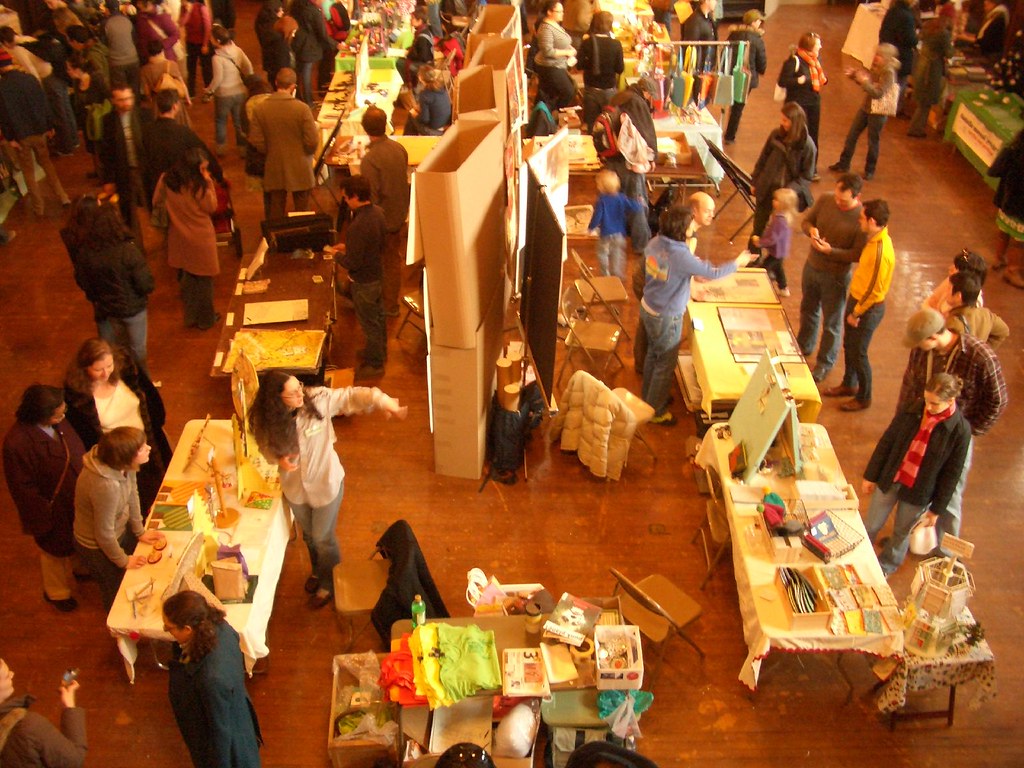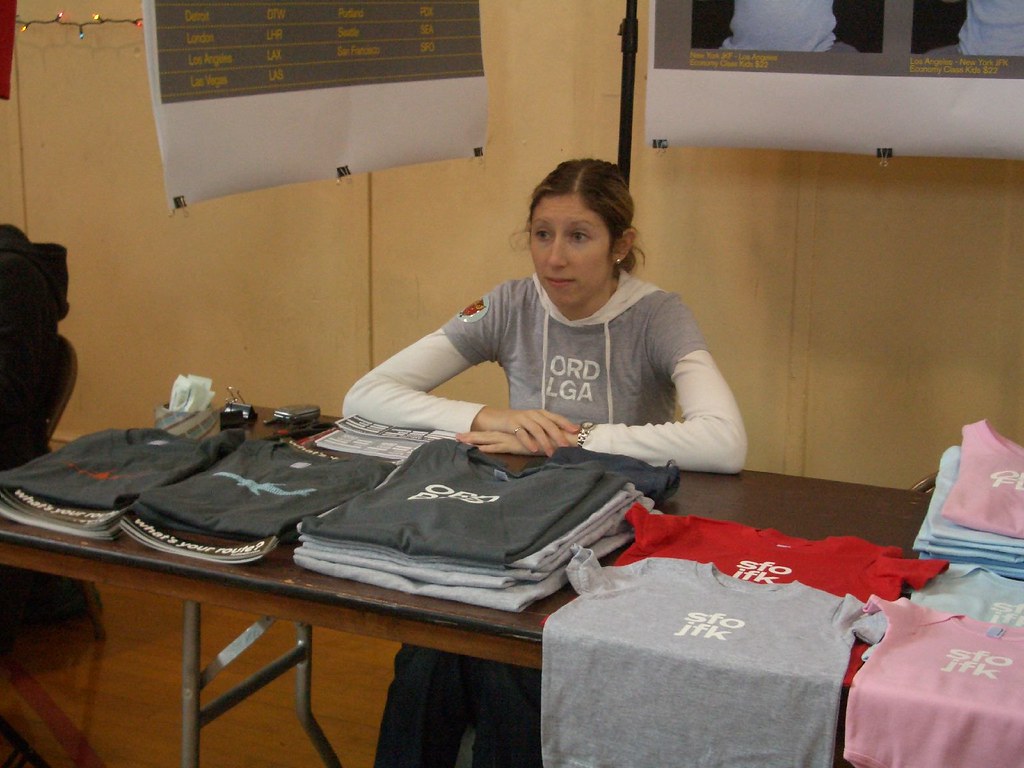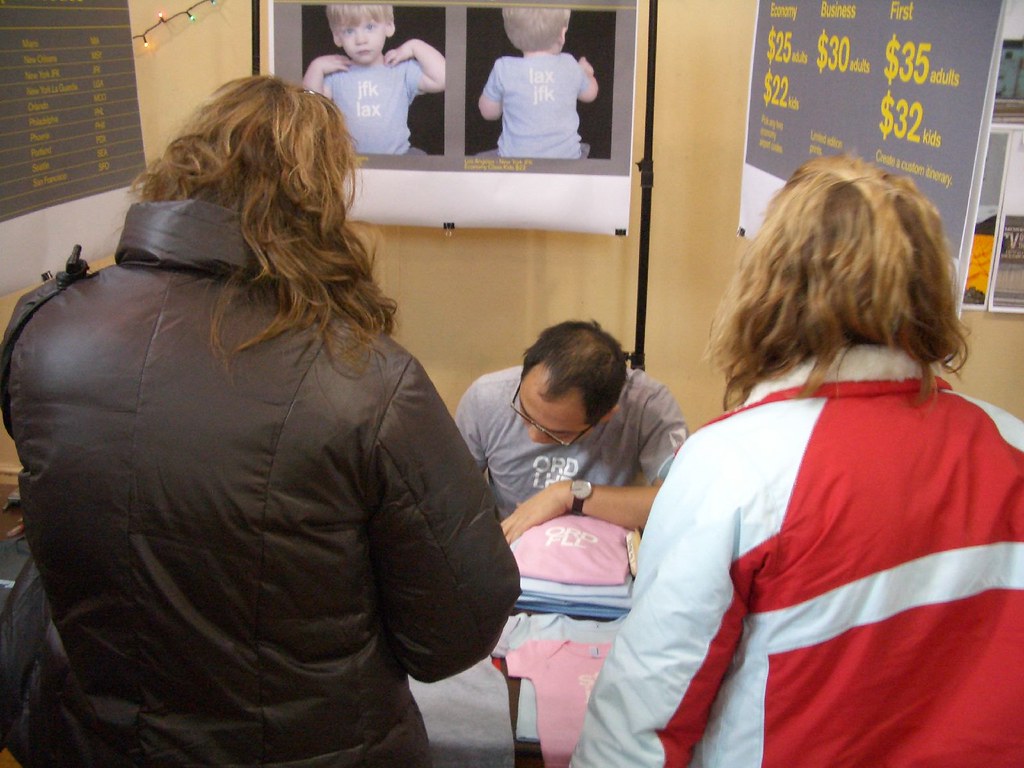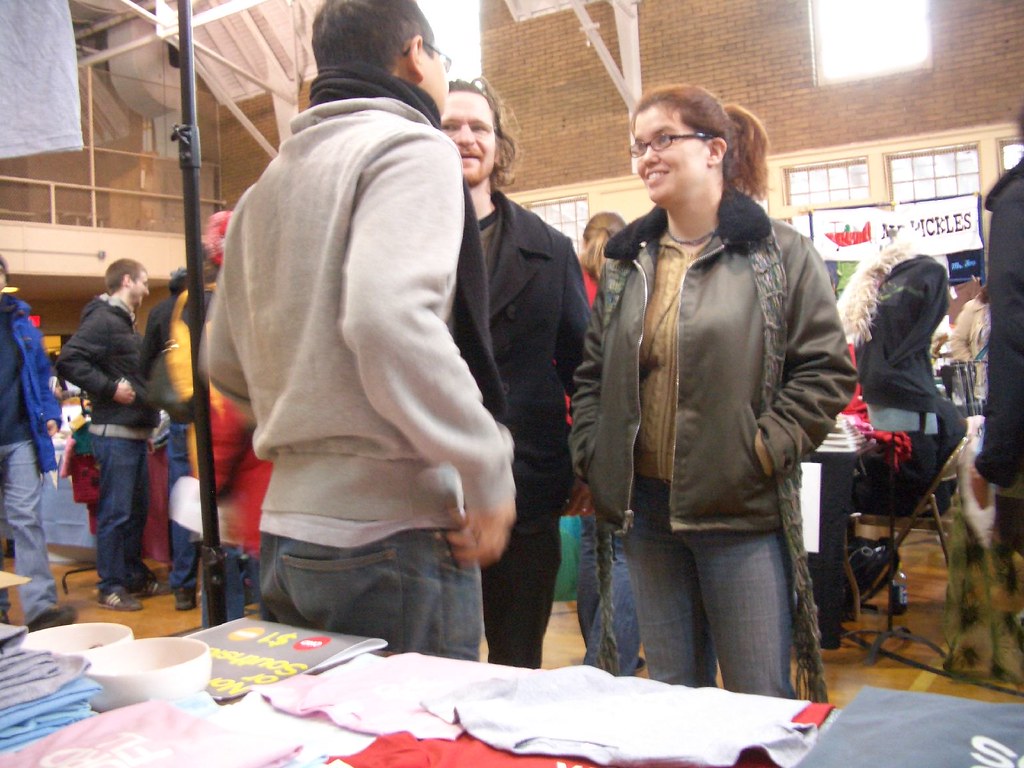 Last weekend, my boyfriend and I exhibited t-shirts at the Renegade Craft Fair. Renegade is your typical urban retail gathering. It's a large group of funky, clever crafters who range from very amateur to quite professional. We are not quitting our day jobs any time soon, but we sold shirts and made connections and boosted our brand awareness. It was a good two days.
Last weekend, my boyfriend and I exhibited t-shirts at the Renegade Craft Fair. Renegade is your typical urban retail gathering. It's a large group of funky, clever crafters who range from very amateur to quite professional. We are not quitting our day jobs any time soon, but we sold shirts and made connections and boosted our brand awareness. It was a good two days.For me, Renegade was especially interesting because as a shopper, I often wonder, "My god, what is this store thinking?" Now, in an unexpected turn of events, I had become the store. So here's what I was thinking.

Lesson 1: Don't stare at shoppers. Don't even look at them. Forget what you know about manners. Don't smile at anyone. It only freaks them out. Don't even make eye contact. At all. Resist the urge to watch the endless parade of fascinating people walking by your booth.
I noticed that when I would look at someone, the minute they saw me looking, they'd start backing away. Politeness is generally a good thing, but as a shopper, intense scrutiny (or even a casual glance) can be a huge buzzkill. I know that when I enter a boutique and I'm the only shopper, and the woman at the counter greets me in a warm and cheery way, I want to get the hell outta there. This effect is magnified in a small, intimate ten-by-six space. So I quickly learned to stop looking, stop smiling and stop freaking people out.

Lesson 2: Look busy. If you are not busy, become busy. Let your "work" consume you. Don't even look up when people approach, until you've given them at least ten seconds to become comfortable in your space. If you are busy, my theory goes, you don't need them. If they want your attention, they're going to have to work for it. It's like a new relationship. You've gotta play hard to get.
I noticed that when I would take up a meaningless task, like refolding all the shirts or reorganizing them into size order, more shoppers would walk up and start browsing. They'd feel more comfortable with that initial approach because they were entering a neutral zone. I wasn't watching over my territory, I wasn't handing them a business card or asking them what size they needed. I wasn't putting on any pressure, and they responded well to my aloofness. Counterintuitive, perhaps. But it worked.

Lesson 3: Fill the space with people. Nothing draws a crowd like a crowd. If your booth has no shoppers, and the booths around you do, people will quickly deduce that your booth has nothing going on. Especially in a transparent environment like a craft fair, with no storefronts or walls to disguise your relative crowdedness, you simply must have people around.
And friends will do just fine. During times when friends were visiting, they would stand right in front of our booth. Were they blocking the merchandise from public view? Sure they were. Was that okay? You bet. Even you yourself are better standing in front of your booth, than sitting behind it. There were times when my boyfriend would sit in the chair, and I would stand in front, just talking to him! And people would come.
The busiest times, of course, would begin when one person decided to make a purchase. As she made her way down the decision tree (size, color, graphics) other shoppers would gather. And if that first purchaser looked like a cool chick, you better believe that helped sales too.
---
Renegade taught me a lot about the subconscious elements of store choice. We notice scrutiny. We notice employee neediness. We notice other shoppers in a big way. So forget everything your mother taught you about manners. The best way to sell product is to ignore shoppers, look cool, and hang out with your friends.

8 comments:
This is brilliant. You summed up my experience - on both sides of the table - perfectly. I've always thought it's comical that big, blustery corporations have Serious Training Sessions about how to behave in a booth, and everything they're told is completely wrong if they're trying to attract me (be super-suited, no food/drink, stand in a particular place and postion--usually behind a table or display--, greet everyone and make eye contact, don't block your stuff, don't socialize with coworkers in the booth, yadda yadda). It'll work great if you want me to walk on by!
Keep up the outstanding observations!
I had an interesting experience recently that was similar to this. I was stationed outside of Rockefeller Center during the Today Show taping, handing out free recipe packets for one of my company's books, Kids Cook 1-2-3. The book's author was being featured on the show.
Now, we were giving out something FREE, mind you. And it was so difficult! Nobody wanted to take it, especially if they had kids with them. Eye contact seemed to make them incredibly uncomfortable, and all the more likely to pass right on by. I thought I was being very friendly, and I surely didn't think my general appearance was threatening. What was going on?
Then, of course, the segment started taping and the book came up on the TVs. A small crowd gathered, and every single one of them eagerly took a recipe packet. And the crowd grew larger, as more people stopped by to ask, "What's going on here?" We got rid of almost all of our packets during the 10-minute segment.
The moral? Never underestimate the power of a crowd!
I ignore customers everyday because they ignore me!! Then when all is busy they stop you in your tracks with their needy little eyes. That is when I smile and help them out. I think it is a love hate relationship...
Honestly I am too busy merchandising to take the time to sell but I will acknowledge them when they walk in the door. It does tend to startle them and freak them out. Welcome to the world of corporate psychology.
Great read and insight! Hope all is well with you.
Thanks all for your comments! Joyce, your corporate booth observations are hilarious and right-on. I've been to a number of industry trade shows, and man, are those things awkward. You are given approximately zero seconds to look at anything, before a well-dressed scarecrow shoos you away. I spend my trade shows walking around with averted eyes, lest any corporate doofus try to hand me a bouncy ball with his logo.
My guess is that at a trade show, about 5% of the audience are sure-bet potentials. Customers waiting to happen. Those people would be receptive to the immediate greeting, the suit, the professionalism. But I'll bet there's another 5-10% who might be teetering on the edge of curiosity, and who are scared off by these tactics. Man, those companies should so totally read this blog.
Stacy, I've found that giving away free things might actually be harder than selling them. I once had to hand out postcards at college campuses. Some people look at you like you've got a third arm. I think that when the item is free, people assume its value is low and that they're better off without it. But if other people are taking it, that's an entirely different story. We are hardwired to believe that popularity = value.
E-fed, it sounds like you take maximum advantage of your position in the store. Keep up the good work. :)
qwpI run a qualitative research firm called Lumiere in Mumbai, India, and one of the things we do is to study shopper behaviour. Nothing works as well as observation does...not to mention insightful blogs on shopping such as yours!
Thanks and do keep observing and sharing...
Deepa
How right you are!
I have a great example of good shopper psychology from my own little town. We have a rather natty "gentleman's outfitter" in the main street - you know, suits, ties, good shirts, cufflinks... Now, most of these shops seem to be run by Jeeves-wannabees dressed up to the nines in the best of the designer-best who seem to sneer at you for even thinking that a button-down shirt could begin to go with those cufflinks.
This shop is different.
The guy running the place has figured out that although you need a suit, you might not be wearing one today, or even feel especially comfortable around them. So, like you, he is dressed in jeans and a denim jacket. Like you, he is unshaven. Of course, he knows his tailoring backwards, and his jeans are perfectly spotless. But it's only after you've been talking to this friendly "fellow shopper" for a while that you realise... he OWNS the place.
Talk about dissolving barriers!
Great post, terrific blog. Thanks.
Adam
Work•Play•Experience
Sara, your mom gave me this link because she's so pleased with your writing ability and knows that I (cousin from Richmond, Va., remember?) am an English teacher and a writer. I am so glad she directed me to you this way and I am pleased to be able to say in all sincerity, you are one hell of a good writer! I like the quirkiness of your thought process and the natural, conversational tone of your writing. Your mom is justified in thinking you are simply terrific. Love, Betty Ann Jaffee
Adam, you touch on something extremely important - the "relatability" of employees to their customers.
I did some research on makeup shopping in London, and the teens I was with walked right past the Chanel counter in Boots. Why? "She was too pretty," they said.
We instead stopped at a brand called Benefit, where the girl behind the counter was cute, sweet and yet, not gorgeous. Certainly not glamorous. While the Chanel woman may have been the pinnacle of beauty, as one of my shoppers put it, "I'll never look like her. But I *might* be able to look like the girl from Benefit."
Betty Ann, it's so nice to hear from you! And I'm thrilled that you like the blog. It means a lot, especially coming from a writer and teacher. Sometimes I think I take too many liberties with the English language (like perhaps, making up words like "relatability!") But I always try to write it exactly how I would say it.
Thanks for reading and stay in touch!
Post a Comment